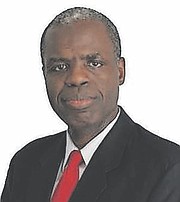By NEIL HARTNELL
Tribune Business Editor
nhartnell@tribunemedia.net
The Central Bank’s governor yesterday disclosed that restrictions on foreign currency outflows imposed at COVID’s peak could have saved up to $500m in external reserves.
John Rolle, speaking as the Central Bank unveiled its 2021 first quarter economic assessment, said the measures introduced exactly one year ago to support The Bahamas’ vital one:one US dollar exchange rate peg had served to keep the country’s foreign currency reserves above the $2bn mark.
“The collective measures, in our estimation, would have provided a cushion in the reserves of between $350m to $500m depending on how you estimate it,” he said. “The impact was real in terms of providing the cushion.
“Then you had the government with its financing activities [foreign currency borrowing] occasionally providing replenishment in the reserves level. Without this money the reserves would be a few hundred million dollars below the $2bn mark at this point.”
To preserve The Bahamas’ foreign currency reserves, and maintain its ability to import reserves at the pandemic’s height, the Central Bank suspended the Investment Currency Market (ICM) that allowed locals and residents to invest in international securities and real estate.
That restriction remains in place today, although Mr Rolle previously pledged that it would be reviewed by the 2021 third quarter, halting between $50m to $100m in annual foreign currency outflows.
The other measures imposed by the Central Bank included a bar on dividend repatriations by the Canadian-owned commercial banks; a relaxation on bank foreign exchange sales to the public; and the National Insurance Board (NIB) liquidating its overseas investment holdings. The dividend restriction has since been relaxed.
Asked yesterday when The Bahamas could reach a “tipping point” in its foreign exchange reserves holdings, Mr Rolle acknowledged that persons were “right to be concerned about tourism and the reserves” but asserted: “We don’t see ourselves in that neighbourhood right now.”
The tourism industry’s shutdown for large parts of 2020, and subsequent slow revival amid local and foreign health-related travel restrictions, means that The Bahamas’ traditional primary source of foreign currency earnings has slowed to a trickle. And concerns have also been raised that the reserves have been inflated by the Government’s foreign currency borrowing.
However, Mr Rolle said the Central Bank possesses sufficient tools to intervene and ensure monetary stability, and the one:one US dollar peg’s preservation, should it become necessary as a result of a protracted economic recovery or further downturn.
The Government, he added, still has access to domestic and international credit markets, and “will have more wiggle room to source some of its financing in the local economy” to help cover the anticipated $950m-plus deficit for the 2021-2022 fiscal year. However, it will still have to raise some of its financing in foreign currency to help protect the external reserves.
“The foreign exchange markets provide a reliable gauge of earnings and demand trends in the local economy,” Mr Rolle said. “On the earnings side, commercial banks’ purchases of foreign exchange from the private sector, which highly correlate with export activities, decreased by approximately 30 percent in comparison to the first quarter of 2020.
“Speaking to the compressed spending capacity of domestic residents and businesses, the demand for foreign exchange usage, mainly for imports of goods and services fell by 14 percent.” Mr Rolle said the fact foreign exchange purchases from the private sector were only down 30 percent, despite tourism being down by more, showed other export sectors were picking up some of the slack.
He added that the COVID-19 downturn had also triggered a self-correcting mechanism for consumers’ foreign exchange demand, as the increase in unemployment combined with the drop in incomes, had reduced the desire for imports.
“As regards the foreign reserves, balances contracted over the quarter by $126m to $2.26bn at the end of March,” Mr Rolle said. “At today’s date, reserves are still around $2.26bn. These are very comfortable holdings to absorb the drawdowns that are expected over the remainder of 2021. Afterwards, the coverage for the Bahamian dollar fixed exchange rate will still be robust.
“There has traditionally been less negative pressure on the reserves in the first quarter of the year, with 2021 being no different, because on a seasonal basis the peak in private spending usually occurs in later months of the year [due to holiday travel].
“This has helped to explain some of the lessened pressures observed in the first quarter. So far, credit to the private sector has not generated strong impulse for foreign exchange, because even within the selective accommodation ranges for new financing that the Central Bank has sanctioned, lending institutions are still very restrained in the current risky environment,” he continued.
“However, public sector expenditures that have been a source of stabilisation to domestic demand have also stimulated important foreign exchange usage. As the tourism business recovers, foreign exchange pressures will lessen further in comparison to 2020.......
“There is also a maintained scope, in the outlook for the reserves, to absorb projected domestic investment expenditures on continued rebuilding of housing and infrastructure in the hurricane damaged areas of The Bahamas.”





Comments
Use the comment form below to begin a discussion about this content.
Sign in to comment
Or login with:
OpenID